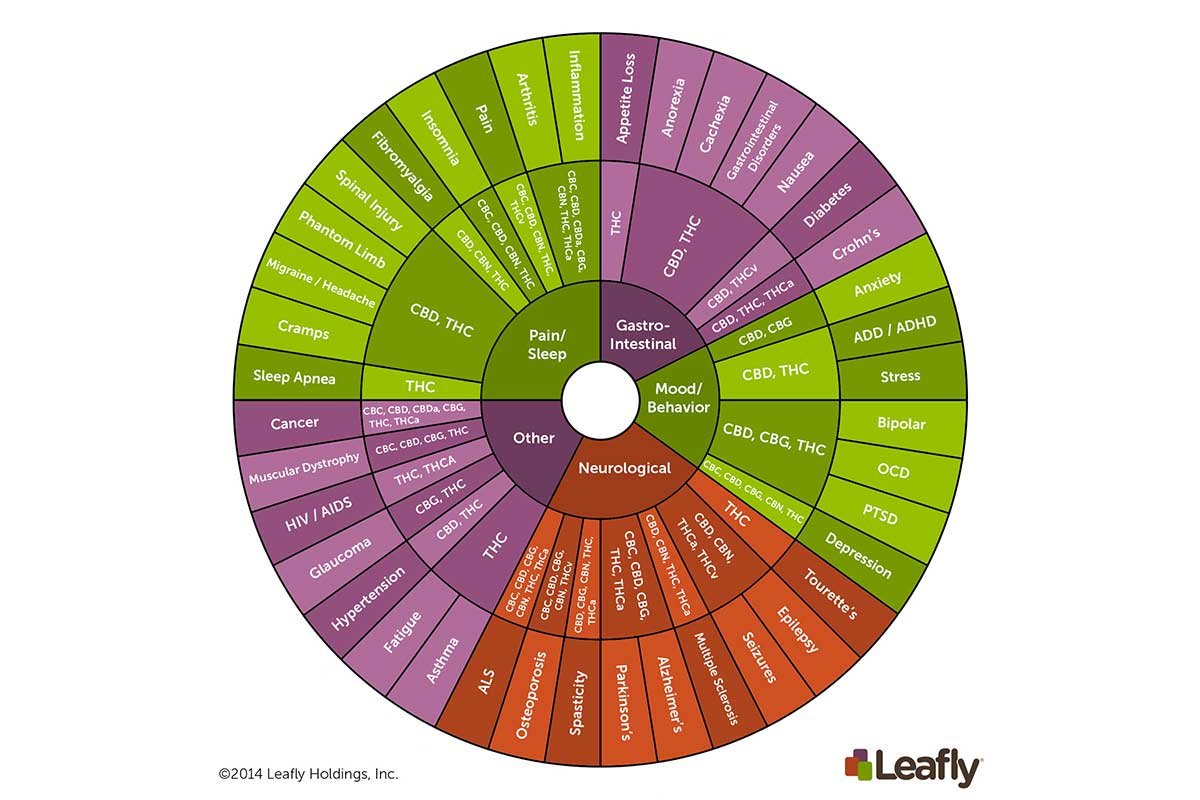Weed. Drug. Banned substance. Medicine. The cannabis plant goes by many monikers.
Recent history has vilified what ancient history commended. Now, as more and more people around the world gain access to cannabis, it’s become better known for its therapeutic properties.
Millions of American use cannabis every day to help treat symptoms of conditions that range from epilepsy to PTSD, cancer, to nausea. Patients most commonly use it to treat chronic pain, and symptoms of Multiple Sclerosis (MS), glaucoma, HIV/AIDS, arthritis, insomnia and inflammatory bowel disease (IBD), to name a few.
But, what makes marijuana medicinal? The (short) answer is cannabinoids.
Cannabinoids – or phytocannabinoids – are the naturally occurring group of active chemical compounds found in the cannabis plant. There are over 100 different cannabinoids; some of the most well known are Tetrahydrocannabinol (THC) and Cannabidiol (CBD).
Both CBD and THC are the main chemicals used in cannabis-based medicine. But, each cannabinoid has a different effect on the body (not all are known). THC is known for the psychoactive or high effect it induces. CBD, on the other hand, is non-psychoactive.
In fact, most cannabinoids do not have psychoactive effects. Each is thought to influence the body in different ways. Research suggests that some cannabinoids like cannabinol (CBN) treat symptoms associated with inflammation or pain, while others (THC, CBD) have neuroprotective qualities.
Individual cannabinoids can be isolated and extracted, or synthesized. The concept is used in the development of synthetic cannabinoid-based medicines, such as Marinol. Isolating compounds allows humans to reap the benefits of particular cannabinoids. However, it’s believed that these chemicals work most effectively when used together, known as the entourage effect.
Understanding Cannabinoid-Based Medicine

So, how do these compounds actually affect our bodies?
When consumed, cannabinoids activate or trigger receptors. Those receptors are found throughout our bodies – e.g. organs, nervous system, brain, connective tissue, immune cells, glands, etc. – and help make up the endocannabinoid system (ECS), a biochemical communication system within our bodies.
To oversimplify: If cannabinoids were keys, receptors are the locks. Once unlocked, receptors send messages to cells.
Researchers have so far found two types of receptors: CB1 and CB2. Each has a different role to play, and each responds differently to various cannabinoids. (There are other receptors thought to engage with cannabinoids, but these are the main ones).
The highest concentration of CB1 receptors is found in the brain and in the spinal cord. CB2 receptors are predominantly found in immune cells and GI tract.
Interestingly, high densities of CB1 receptors are found in the hippocampus, cerebellum and other regions in the brain responsible for regulating appetite, mood, memory, etc. They’re also found in nerve endings.
Due to the concentration of CB2 receptors in immune cells, they are thought to help the body respond to disease.
These receptors are also activated by our body’s own cannabinoids aka endocannabinoids. One such endocannabinoid is anandamide or the bliss molecule. It’s a neurotransmitter that’s produced on demand by the body when it’s needed. Anandamide is fragile, like all other neurotransmitters. It’s known to regulate mood, appetite, pain, cell regulation, and even reproduction.
A scientific study published last year was the latest to focus the research community on the potential of the GPR55 receptor, which is now known to be the third identified receptor.
Unlike most other cannabinoids, research suggests that CBD does not directly bind to the receptors mentioned above. Instead, it’s believed to help build up our body’s supply of anandamide. It does this by inhibiting the FAAH enzymes that deplete levels of anandamide, and other endocannabinoids.
Despite a more than 5,000 year history of safe, medicinal cannabis use, science is just starting to understand cannabinoids, cannabinoid-based medicine and the ECS. What we do know about this complex system is that it has a vital role to play in the human body.